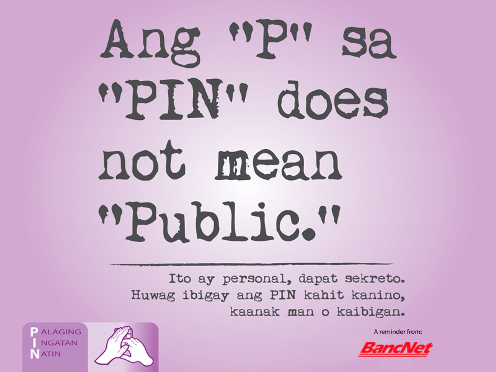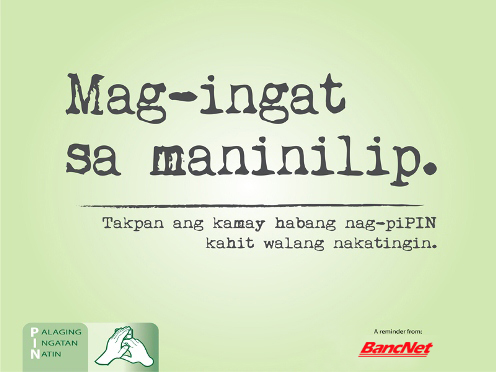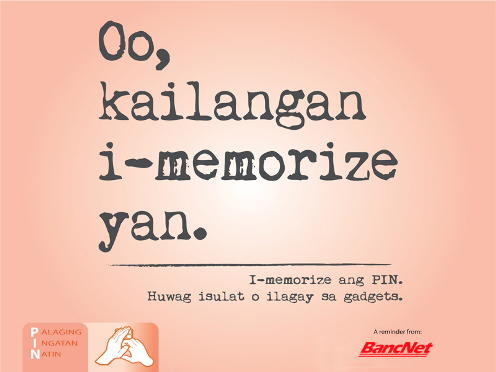The bank tells you to be careful about tearing up the PIN Mailer that we give you with a new ATM card. At Queenbank, only you, the cardholder, will have access to your own PIN - even senior bank officials will not be able to access it as the bank software encrypts it before being stored in our databases. But did you know that there are more things that you can do to protect your number and ensure that nobody else tries to use your account? ATM cards are very attractive to would-be thieves because immediate cash is always more desirable than goods on a credit card. Here are some additional, simple steps for you to take to protect your PIN (personal identification number):
1. Never share the PIN. It might be tempting to trust a friend or a family member with your PIN but it is not a good idea. Circumstances can change and sometimes, people perceive a need more greatly than maintaining your trust or worst still, a person you do trust might be placed in a compromising position with a third party and be obliged to reveal your PIN under harassment or threat. It is better not to put this to the test, ever.
2. Never give out your PIN in response to e-mail or telephone requests. Phishing scams are unsolicited e-mails asking for bank account details, passwords and PINs. Delete them without a second thought and never respond to them. Also, never provide your PIN over the telephone; there is never a need to do this and it will always be a fraudulent request. Queenbank and any of its affiliates will never make you reveal your PIN in whatever manner and for whatever reason.
3. Shield your PIN when using it. Use your hand, a checkbook, a piece of paper etc. to shield the PIN as you enter it into an ATM machine. Be especially vigilant in wide open public queues, where somebody may be paying more attention than you. Also, be wary of "card skimmers" at ATMs; they use scanners run over the card slot to lift debit card details and they find your PIN details via camera or looking. If you shield your PIN input well, they are hampered in their attempt.
4. Choose a PIN password that is not obvious. Your birth date, wedding anniversary, phone number and home address are obvious picks, so just do not use them. Instead, think of numbers unrelated to major events and addresses (not listed anywhere or on anything in your wallet) in your life to create your PIN. See TIPS section below for more details on this.
5. Do not write your PIN down on the card, EVER!!! Do not even write it in a diary. If you must write it down, disguise it in some way or put it somewhere totally unrelated to the card, such as in your favorite page in the middle of your favorite book.
6. Try to vary your PIN on different cards. Try not to keep the same PIN for all your ATM cards, Debit/Gift cards and Credit cards. Attempt having a different PIN for each one, so that if you do happen to lose your wallet, it will be much harder for the PINs to be cracked.
7. Contact the bank immediately if your card is stolen or lost. Tell any branch personnel immediately if you think that there is anything that may compromise your PIN, such as an easy PIN, other ID in your wallet making it easy to work out or, horror of all horrors, the PIN being written down somewhere in the wallet or on the card. Get the bank to cancel the card immediately.
8. For better security, change your PIN regularly. Change your PIN immediately if you suspect that your account has been compromised and in cases like after you receive back your card from a loan agent / agency.
Source: http://www.wikihow.com/Keep-Your-Debit-Card-Number-(PIN)-Safe
1 .Respect the privacy of others using ATMs and card swipe machines; give them space and don't stare at the keypad.
2. Do not disguise your PIN as a telephone number: Crooks know this trick and one of the first places they will look is at the telephone numbers in your address book or contacts in your mobile phones.
3. Be diligent about regularly checking your account to make sure no unauthorized transactions have been made using your card.
4. One way to create a PIN that is also easy to remember but hard to guess is to translate a favorite 4-letter word or your favorite person's name into numbers (like on a telephone keypad). Ex: "Love" would be 5683 or "Mary" will become 6279. Some ATM keypads have letters printed alongside the numbers. (Do NOT use your own name)
5. Method of writing it on a card with some level of security: a) Come up with a unique number that you will never forget. b) add or subtract that number from your real pin c) Write the derived number on the back of the card (this will frustrate a would-be thief) d) use the same formula for your other pins so that you only have to memorize the formula and not the actual pin numbers.
6. Another technique that works for PINs is to divide them into two groups of two digits and treat each as a year - so that, say, 8367 becomes 1983 and 1967 - and then find some event that corresponds to each year. Each event should be something personal, known only to you, or something historical but relatively obscure. From these, devise an amusing and odd phrase linking the two events, from which the events themselves, and thus the dates, cannot be easily deduced. Note this phrase down rather than the PIN itself.
7. If you are a very forgetful person, try to memorize the PIN using memory techniques. Mobile phone Apps that disguise PINs can also be used. For example, Pin Code Keeper for Android or SafePin for iOS lets you hide your PIN code within colored segments in a matrix on the principle you choose. Just type the digits into the segments of a preferable color in a preferable place (for example, in the upper-left corner). Do this when no-one sees you. Your PIN code is fully protected and you can safely turn to the app in public.
1. Contact the bank immediately if an ATM "eats" your card. This is possible evidence of the ATM being used in skimming fraud.
2. Use the same ATM for more security, and keep an eye on it's surroundings e.g.: pin pad height, there's a difference around the monitor or something new added to the machine in case there's a skimming fraud going on. If in doubt contact the bank in charge of that ATM.
3. Keep in mind that if you do allow someone to borrow your card and PIN, the bank has the legal right to deny you a refund should the card be compromised. This is considered lack of due diligence on your part to protect the information.
4. Do not worry about keeping your debit or credit cards near magnets (e.g. magnetic locks of a wallet); the pull of the magnet will not demagnetize the cards or wipe any information from them. However, directly wiping them with a very strong magnet on or in very close proximity to the magnetic stripe will erase them or damage the data.
5. Never write your PIN on a postcard or outside of an envelope.
Source: http://www.wikihow.com/Keep-Your-Debit-Card-Number-(PIN)-Safe







